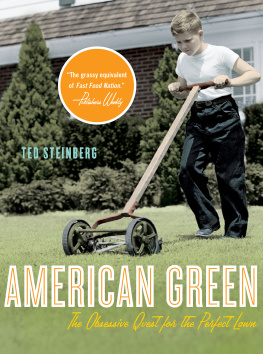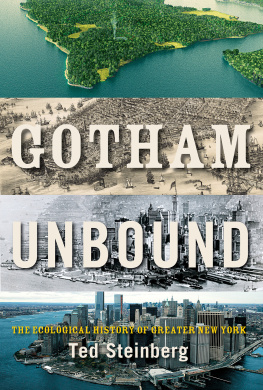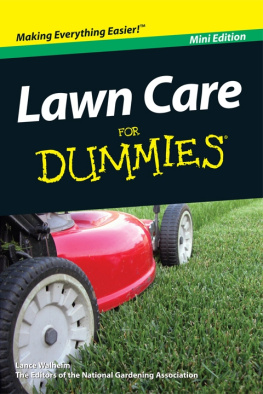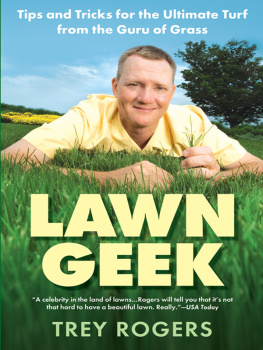
OTHER WORKS BY TED STEINBERG
Down to Earth:
Nature's Role in American History
Acts of God:
The Unnatural History of
Natural Disaster in America
Slide Mountain,
or the Folly of Owning Nature
Nature Incorporated:
Industrialization
and the Waters of New England

W. W. Norton & Company
New York London
I guess you could say that lawns have really grown on me. So first Id like to thank my barber, Peter Perron, for taking good care of the beard I decided to grow for some reason during the course of this project.
If Jonathan Sadowsky still cant find his way to the perfect lawn, at least he can find the time to indulge my wild intellectual escapades. My friend Jim OBrien, meanwhile, has been mowing me down with brilliant advice for years. So what if the Imperial Diner was really a caf. Daniel Berick, Michael Black, Robert Hannigan, Peter McCall, Joshua Palmer, Helen Steinberg, and Madeline Steinberg all gave the manuscript a challenging read and offered detailed comments and invaluable advice. My thanks, as well, to all those who suffered through my turf hysteria, including Tim Beal, Jared Bendis, Peter Berg, Jerry Blondell, Bruce Borland, Bruce Branham, Maria Cinque, Dan Cohen, Pete Cookingham, Peter Costich, Sue Depoorter, Brian Donahue, Stephen Dory, Mark Doyle, Elsie Finley, C. Reed Funk, Sharlane Gubkin, Liza Hazirjian, Kirk Hurto, Brian Inouye, Judy Kaul, Cathy KellyDan Kerr, Bonnie Klein, John Knott, Tom Kowalsick, Nancy Kryz, Rube Lamarque, Ken Ledford, Larry Malley, Carl Mariani, John McNeill, Jennifer Mearns, Bruce Mizrach, Kevin Morris, John R. Murphy, Robert OKnefski, David Pimentel, Ken Pomeranz, Jennifer Price, Steve Pyne, Smith Reed, Arthur Remillard, Paul Robbins, Alan Rocke, Adam Rome, Marissa Ross, Frank S. Rossi, Michele Rubin, Robert Russell, Renee Schwartz, Randall Scott, John B. Sevart, Elly Shodell, Walter Simonson, Lynwood Smelser, Frank Stadelberger, Lewis Stein, Robert Strassfeld, Karen Thornton, Ralph Tuthill, John Wargo, Andy Wasowski, Richard Weir, James Boyd White, Ben Wisner, Jonathan Wlasiuk, Donald Worster, and Tamson Yeh.
Im grateful to my students in History 378, Environmental History of North America, who contributed in so many ways to this book. And to the following institutions which offered speaking opportunities as well as research and financial support: the Baker-Nord Center for the Humanities, the History Department, the Kelvin Smith Library, and the School of Law, all at Case Western Reserve University; Ball State University, the University of Michigan, the University of Oklahoma, Oberlin College, and Florida State University. Special thanks to the Special Collections department and the Turfgrass Information Center, both at Michigan State University.
Donald Lamm showed support for this book early on and introduced me to Joe Veltre, who, hands down, remains the gold standard in the agent department. Working with the people at W.W. Norton was one of lifes great pleasures. Amy Cherry is probably the only editor in the world without a back yard who would take on a lawn book. At a minimum, for all her support and hard work, I owe her a couple of rolls of sod.
You cant depend on your judgment when your imagination is out of focus.
MARK TWAIN
AMERICAN GREEN
The Obsessive Quest for the Perfect Lawn
Ted Steinberg
The greatest service which can be rendered any country is, to add an useful plant to its culture.
THOMAS JEFFERSON
Jimmy, the neighborhood kid who cut our grass on Long Island and nearly disappeared into our abandoned cesspool, could have died for our lawn, but didnt. Frank Meyer, arguably, did.
Frank Meyer was born in 1875 in the Netherlands and came to the United States at the age of twenty-five. He felt about plants the way some men today feel about their cars. His passion for botany and love for the outdoors led him to become one of the most productive plant explorers ever, traveling to China, Manchuria, and other parts of Asia beginning in 1905 and introducing a stunning twenty-five hundred new species into the United States. Meyer changed the face of America, importing Siberian elms that were planted as windbreaks by the thousands in the Great Plains. He introduced Americans to the Chinese pistachio, the Kashgar elm, the Khotan ash, the Feicheng peach. He brought back forty-two new soybean varieties alone. Then, in 1918, while cruising the Yangtze, he got up in the middle of the night and was never heard from again. A week later a Chinese boatman found his body floating in the river.
I say Meyer died for our lawn because of a discovery he made in a field of grass during the summer of 1906. His daredevil explorations had led him to northern Korea, having crossed treacherous mountain passes, waded through rivers, even rescuing a box of provisions that went sailing into the water after a horse lost its footing and tumbled downhill. Then he found it, what he described as a perennial grass growing but a few inches high, well adapted for lawn purposes. Needs mowing, in all probability, but once or twice a year and requires very little water. Meyer happened upon a variety of zoysia (named after the eighteenth-century Austrian amateur botanist Karl von Zois). He sent the seed to the U.S. Department of Agriculture, where scientists set about improving it. In 1951, the Agriculture Department and the U.S. Golf Association released Meyer zoysia, named to honor the man who risked his life rooting around on his hands and knees for the sake of better homes and gardens.
Zoysia is sometimes described as miracle grass, and with some justification. Its a warm-season grass that tolerates heat and stays green in the summer, when Kentucky bluegrass struggles mightily to keep its color. It produces a thick, dense carpet of turfgreen velvet turf is how Meyer described his Korean discoverythat will allow you to retire the keep off the grass signs. It grows so thick and strong that it is virtually impossible for crabgrass, dandelions, and many other weeds to invade it. Hence it needs little in the way of herbicide. And the best news of all is that zoysia requires less water, less fertilizer, and less mowing (because it grows slowly) than bluegrass, rye, or fescue. Its as if Rachel Carson were reincarnated as a roll of sod. With environmental virtues like these, why arent zoysia lawns as common as Korean businesses are in Los Angeles?
The answer takes us to what is by all accounts zoysias main weakness: it turns brown in the fall and doesnt green up again, in northern areas like New Jersey at least, until May. While blue-grass might stay green ten months of the year, zoysia retains its color for only a bit more than half as long. The only solution for those hopelessly in love with green is the Grecian Formula approach: turf paint. One coat should last all winter.
How my father found out about Meyer zoysia, which unlike other varieties is especially tolerant of cold weather, is hard to say. He could have been influenced by the power of advertising: Makes a lovely green carpet so strong that two men cant tear apart a strip of AMAZOY sod, reads one 1957 ad. He could have perhaps encountered the grass while playing golf. One thing is clear: my father had no idea how to pronounce his discovery, saying it in a way that made people think he was talking about the nearby Long Island town of Syosset. (Its supposed to be zoi-s-uh.) Nevertheless, sometime in the late sixties, Dad and I went out to the front yard to plant zoysia plugs, round hunks of turf that eventually spread out to form the crabgrassproof lawn that has indeed saved time and money over the years, something my father, an accountant by trade, would have appreciated. Today, a generation after my fathers death, the zoysia is still therebeautiful green grass shimmering gloriously under the summer sunliving proof that the royal road to lawn perfection can be seeded (plugged, in this case) with common sense.
Next page








